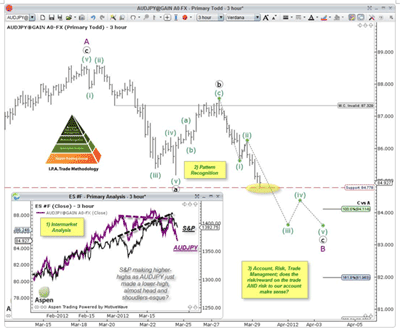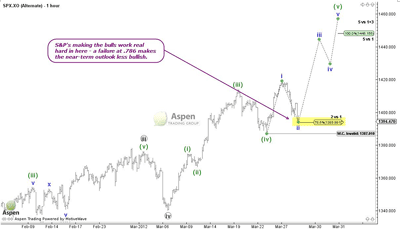This real trade review courtesy of Dave Floyd shows not only the importance of pre-trade planning, but also how a true professional assesses their trades in order to continually learn and improve.
Good morning traders. One of the things that my fellow trader and business partner Todd Gordon and I made a conscious decision on heading into 2012 was always being aware of the overall trend in the markets we are trading/monitoring.
While we have never been ones to fight the trend, there were times in the past where we might try to take the analysis to a point where we were trying to get in front of the market rather than trading in sync with the market. The result has been a marked improvement of win/loss ratio and an upward-sloping profit and loss (P&L) curve that is absent sharp drawdowns.
Looking at a recent AUD/JPY trade, even without the benefit of hindsight, we can see some areas that perhaps were not fully worked out in the pre-trade analysis. Let's explore them here as a way to avoid a similar mistake going forward.
You always want your lead market and/or related asset class to be one of the primary drivers so that you get the wind at your back. In the case of shorts in AUD/JPY, we will want to see weakness in equities (i.e. S&P 500). While there has been weakness in the last few days in the S&P, the overlay chart shows that the S&P futures are lagging AUD/JPY.
That is certainly OK because if the S&P futures do break lower, we know that AUD/JPY would sell off sharply. In this instance, however, the futures were tackling a key support level at 1394.
At the time we contemplated initiating the short in AUD/JPY, prices were testing that 1394 level but not getting a meaningful bounce higher from it; a characteristic you want to see to have confidence that level will hold. Hence our decision to get short but keep a close eye on subsequent price action, which we did.
What we did do quite well last week was identify two very robust resistance levels in the S&P futures at 1416/1426 and 1442/1450. If you want to fade a trend, you have to do it at levels that are very uncomfortable and not wait for the market to react lower (in this case) and then sell into the correction higher. Getting short AUD/JPY into those levels, while a bit unsettling, would have gone on to be the lower-risk entry.
There are two other pieces that were not completely factored in, and frankly, they are tricky regardless, as it is impossible to predict the impact of both month-end and quarter-end flows as well as any impact due to the end of the Japanese fiscal year.
As traders, we can never expect perfection on every trade, but what we can demand of ourselves is a rigorous pre-trade checklist that should be completed before execution. So, did AUD/JPY not meet the minimum criteria? That is open to discussion, as there were some points that in retrospect did not completely line up as noted above.
So, moving on and looking ahead to mid-April, it seems clear that the S&P futures will want to explore the upper resistance level at 1442/1450, and thus, we should start looking to position accordingly. Pairs and crosses that are lining up nicely with this general outlook are shorts in both USD/NOK and EUR/GBP.
By Dave Floyd of Aspen Trading Group























